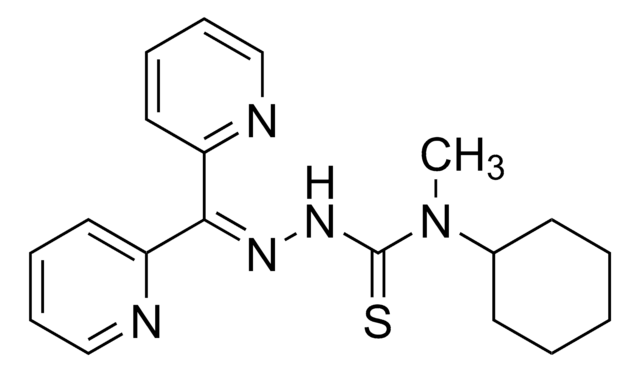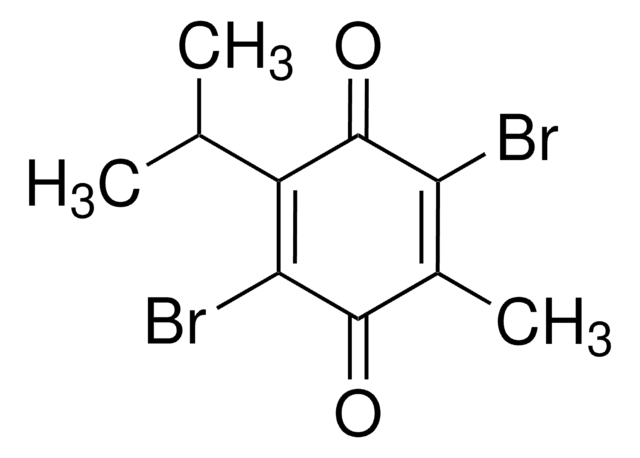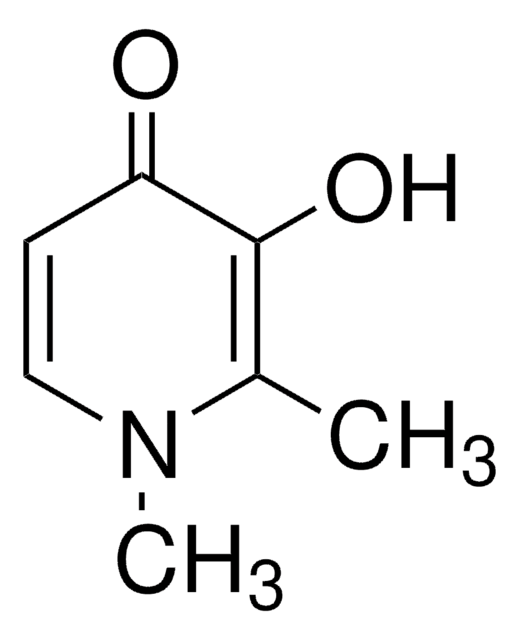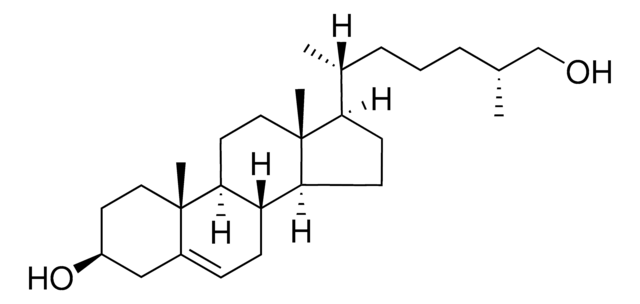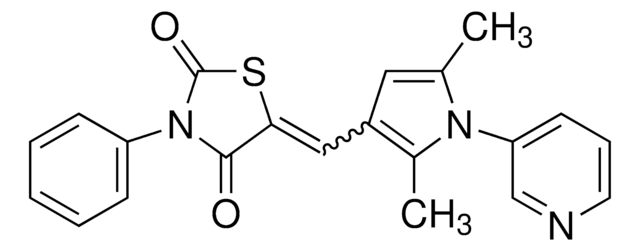推薦產品
品質等級
化驗
≥98% (HPLC)
形狀
powder
顏色
yellow to orange
溶解度
DMSO: ≥5 mg/mL
起源
Bayer
儲存溫度
2-8°C
SMILES 字串
CN(C)C(=S)N\N=C(\c1ccccn1)c2ccccn2
InChI
1S/C14H15N5S/c1-19(2)14(20)18-17-13(11-7-3-5-9-15-11)12-8-4-6-10-16-12/h3-10H,1-2H3,(H,18,20)
InChI 密鑰
XOBIGRNRXCAMJQ-UHFFFAOYSA-N
應用
Dp44mT may be used in cell signaling studies.
生化/生理作用
Cell-permeable iron chelator and top2a activity inhibitor
Dp44mT (di-2-pyridylketone-4,4,-dimethyl-3-thiosemicarbazone) influences lysosome integrity through copper binding. It induces reactive oxygen species (ROS) generation by redox cycling of iron complex. Dp44mT exhibits anti cancer action by attenuating Ndrg-1 (N-myc downstream regulated 1), a metastasis suppressor protein. It also alters the cyclin family of proteins (A, B, D1, D2,D3 and cyclin-dependent kinase 2) known for cell-cycle regulation. Dp44mT is known to promote apoptosis in neuroepithelioma, melanoma and breast cancer.
Dp44mT is an iron chelator that works as a selective anticancer agent. As other iron chelators it can serve as a therapeutic adjunct to doxorubicin treatment. Additionally Dm44mT possess DNA-damaging activity. It appears that that activity is mediated by top2a inhibition.
特點和優勢
This compound is a featured product for Apoptosis research. Click here to discover more featured Apoptosis products. Learn more about bioactive small molecules for other areas of research at sigma.com/discover-bsm.
This compound was developed by Bayer. To browse the list of other pharma-developed compounds and Approved Drugs/Drug Candidates, click here.
注意
Material appears to be unstable in solution; make solutions immediately before use.
訊號詞
Danger
危險聲明
危險分類
Acute Tox. 3 Oral
儲存類別代碼
6.1C - Combustible acute toxic Cat.3 / toxic compounds or compounds which causing chronic effects
水污染物質分類(WGK)
WGK 3
閃點(°F)
Not applicable
閃點(°C)
Not applicable
The iron chelator Dp44mT causes DNA damage and selective inhibition of topoisomerase IIalpha in breast cancer cells
Rao VA, et al.
Cancer Research, 69(3), 948-957 (2009)
Fereshtehsadat Mirab et al.
PloS one, 14(1), e0211078-e0211078 (2019-01-25)
Treatment of glioblastoma, the most common and aggressive type of primary brain tumors, is a major medical challenge and the development of new alternatives requires simple yet realistic models for these tumors. In vitro spheroid models offer attractive platforms to
Pengcheng Li et al.
American journal of translational research, 8(12), 5370-5385 (2017-01-13)
Di-2-pyridylketone-4,4-dimethyl-3-thiosemicarbazone (Dp44mT), the novel iron chelator, has been reported to inhibit the tumorigenesis and progression of various cancer cells, including neuroblastoma, neuroepithelioma and prostate cancer. However, whether Dp44mT has anticancer effects in osteosarcoma is still unknown. Here, we investigated the
Chaowei Shang et al.
Oncogene, 39(29), 5201-5213 (2020-06-17)
The mammalian target of rapamycin (mTOR) functions as two complexes (mTORC1 and mTORC2), regulating cell growth and metabolism. Aberrant mTOR signaling occurs frequently in cancers, so mTOR has become an attractive target for cancer therapy. Iron chelators have emerged as
Antitumor activity of metal-chelating compound Dp44mT is mediated by formation of a redox-active copper complex that accumulates in lysosomes
Lovejoy DB
Cancer Research, 71(17), 5871-5880 (2011)
我們的科學家團隊在所有研究領域都有豐富的經驗,包括生命科學、材料科學、化學合成、色譜、分析等.
聯絡技術服務